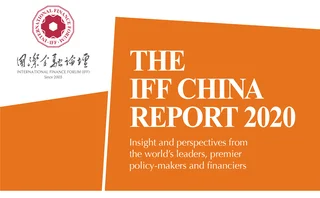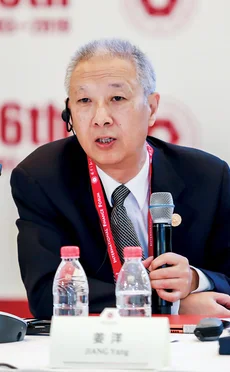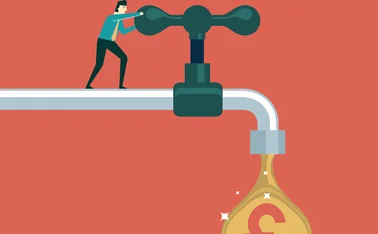
Futures market can carry carbon cost


The Chinese government wants to ensure the continued coexistence of humans and nature through green development, a consensus shared globally. China agreed to the Kyoto Protocol in 1995 and signed up in 2016 to the Paris Agreement on climate change, which commits to lowering the earth’s carbon emissions by 2050.
A transition to a greener, more sustainable economy will be crucial for the continued development of the Chinese economy. Since the 18th National Congress of the Communist Party of China (CPC) in 2012, China has committed to green development, and so far its efforts have borne fruit. Emissions per unit of GDP have dropped by 46% since 2015, achieving the national carbon dioxide reduction goal of 40%–45%.

Controlling and reducing carbon emissions is a crucial instrument in slowing global warming and addressing climate change. Fossil fuel energy is one of the main sources of carbon emissions – limiting their use and advancing the development of new and sustainable forms of energy will be important for China as it advances.
Currently, vehicles that run on renewable energy in China account for 50% of the global total. Each year, China looks to find new ways to continue reducing its fossil fuel emissions, but some technical problems remain. For instance, batteries are still too big and do not last long enough. Nearly 200 new energy vehicle companies in China are exploring ways of solving this problem. Controlling and reducing carbon emissions is essential for pollution control and to contribute to energy conservation – and China’s efforts within the car industry are just one way in which the country is fulfilling its international obligations to address climate change.
An excess of carbon emissions has, in a sense, been triggered by externalities; they are a side effect of economic activity, not costed in. Pollution is caused by enterprises, yet the costs have to be borne by all of society. It is therefore essential to address pollution levels by combining social costs with personal and company costs. The establishment of carbon emissions trading market aims – through market and price – would prevent people from being harmed by external spillovers. Unlike a free market, which trades physical commodities, an emissions trading market circulates products stipulated by government policies. Transactions are generated upon different quotas, and the amount of quota allocated is related to the demand of enterprises. More emissions would call for more quotas, and vice versa. Any surplus quotas can be sold on. The government can exploit policies to manage quotas and the products under statutory powers can be differentiated from general commodities. The establishment of the market may have to go through a process different from general commodity market transactions. With a carbon market trading system in place, a price for carbon emission rights can be formed, which could pave the way for low-emission subjects to gain a competitive advantage and force high-emission subjects to pay greater costs, incentivising social capital to lean towards low-carbon technology and low-carbon projects. It is a more appropriate public policy tool.
The European Union was the first jurisdiction to establish a carbon emissions trading market, and some US states, including California, have also taken action. Between 2005 and 2011, the international carbon market developed very quickly. However, following the global financial crisis of 2007–08, carbon trading in the European market dropped like a stone.
Europe, the US and the wider global economy are suffering from an economic downturn, lowering demand for carbon and casting a pall over the carbon market. From 2012 to 2019, there was almost no liquidity in the market – internally, redistribution quotas are to blame. Excessive quotas put on the market led to oversupply. With fewer companies and less demand, prices have fallen, leading to the downturn between 2012 and 2017. After 2018, when the EU expanded the scope of emissions control, more companies increased demand for carbon emission reduction rights and the market gradually recovered. By the third quarter of 2018, carbon market trading reached €25 per tonne, and the market function came into play again.
Key operations of carbon trading
First, a government’s public policy must be rational. The extent to which emission reduction targets will be achieved and how emission reduction subjects are determined directly influence the scarcity of carbon emission rights, carbon prices and market scale. For products traded on the basis of market quotas set by government public policies, it is essential to consider overarching regulation and stability from a market perspective. The amount and ownership must be clearly defined by law, and the policy must be enforceable. If it is not, it is doomed to affect the price and increase risk within the market.
Second, a central registration and settlement system needs to be built for trading. An example of this type of system is the China Securities Depository and Clearing Corporation (CSDC) for stocks – all data for buying and selling stocks is collected by the CSDC for settlement and account checks. To establish a carbon market, it is important to have a system to collect public information, such as the number of products traded each day and where they are registered. The credibility of the registration agency, and the number of transactions after each day, will be key to market success.
Third, carbon emission verification methods should be improved. A quota amount needs to be checked by the registration agency, and the volume of transactions should be based on the registered content and amount. It would be difficult for the market to operate if there is oversupply. In addition, governments or public institutions should heed the quota amount when issuing; too many quotas will undermine the market and affect pricing.
If these three elements are implemented, issuance and trading within the carbon market will be reliable and secure. The current European market combines cash commodities with futures. In the transaction, data from the carbon futures market is revealed, which creates a more transparent and continuous trade. The higher involvement of financial institutions, as a result, leads to more accurate pricing. The liquidity provided allows many companies to buy and sell for the purpose of risk management, which can be attributed to several major mechanisms of the futures market. The first is the T+0 mechanisms, or day trading. The second is the leverage mechanism. In some commodity markets, one spends CNY100 for products worth CNY100. In a futures market, products are bought with 5% of the price given as an advance payment. Delivering the product without increasing the inventory in the registration system improves efficiency and reduces costs. Thanks to this mechanism, the European carbon trading market is more active, with carbon futures accounting for more than 90% of total trading volume. However, these two mechanisms may bring potential trouble such as speculation, risk control and market measures problems. This means strong supervision is paramount. Regulators are expected to share information with authorities in charge of emission rights to build a risk prevention system. Risk control and regulation are key to the successful and healthy development of the carbon market.
The achievements of China’s carbon market
Building a carbon market in China is one of the goals of the 13th Five-Year Plan (2016–20). In 2012, the 18th National Congress of the CPC proposed implementing a pilot carbon trading market. At the 2015 UN Climate Change Conference, President Xi Jinping stated that its development would be an important aspect of the Five-Year Plan. It became clear that formulating policy to allow for a functioning national carbon emissions trading market was a priority for China.
Following the pilot, China established a unified carbon market across the country. In 2011, the National Development and Reform Commission (NDRC) elected seven pilot cities, which by the end of 2018 covered nearly 3,000 key emission units of electricity, steel and cement. Around 300 million tonnes of carbon emissions were being traded, resulting in a turnover of more than CNY6 billion. The results of the pilot have been remarkable and resulted in a reduction in both the total volume and the intensity of carbon emissions. However, it is still far from the real target of carbon emissions. The problems in the pilots lie in the differences in policy systems, market bases and trading rules, which have led to significant differences in pilot carbon prices. The pilots also pay less attention to preventing market risks such as product financialisation and overspeculation.
After strenuous improvements, the national carbon emissions trading system was officially launched at the end of 2017. In April 2018, China transferred the State Council’s main carbon authority from the NDRC to the Ministry of Ecology and Environment (MEE), offering a stronger institutional mechanism for further accelerating the construction of the national carbon market, which has made concrete progress in the areas of infrastructure development and capacity building.
The carbon classroom
China must learn from other success stories worldwide. In Europe and the US, carbon futures and carbon cash commodity markets function simultaneously, which can boost mutual development. The cash commodity and futures markets will be conducive to the formation of carbon prices, and can enlarge the two core functions of circulation of transactions and risk hedging.
There is also the issue of preventing the emergence of illegal futures. Since the establishment of the futures market in China in the 1990s, disguised and illegal futures have continued to emerge. The central issue is that the cash commodities market witnesses fewer transactions per day and thus has less liquidity. Exchanges hope to activate trading but have increased transaction fees at the same time. If the market is to develop, the sole focus cannot be profits – institutions need to consider leverage, goods being traded and current futures trends.
So, if carbon trading starts in the cash commodities market, will the market fall into the same trap it has for the past 30 years? Problems can be avoided if China builds carbon futures and the carbon cash commodities market together, and rolls out corresponding supportive measures in risk control and supervision.
China should also increase the pace of national unified carbon market trading. Through unified carbon emission reduction policies, the country should launch a new registration system that will help authorities address distortions in pricing signals brought about by differences in carbon trading prices. Currently, there are inconsistencies in how carbon emission rights are allocated in each pilot city, which has impacted emission verification methods and trading system rules.
The Interim regulations on the management of carbon emissions trading, released by the MEE in April 2019, should be promulgated. Focusing on the rarity of carbon emission rights, China can improve the carbon emission rights allocation system, and include more industries and enterprises. Meanwhile, it is imperative to improve the governance of carbon emission verification agencies, train professional personnel and continuously improve market capacity building.
China should also consider accelerating the development of the Guangzhou carbon futures market. The Outline development plan for the Guangdong–Hong Kong–Macao Greater Bay Area proposed setting up an innovative futures exchange with carbon emission rights as its first trading commodity.
The Asian giant should also look to establish a supervision and risk prevention and management system for a carbon futures market. With 30 years of experience in the commodity futures market, China has designed a set of systems suitable for its domestic environment. China has also established the futures market by learning from Western examples and adapted them to local contexts. Many years of exploration and analysis were needed before finally formulating rules that have since been recognised globally. Some of China’s commodity futures contracts are the most liquid in the world with the largest daily volumes. The carbon market can certainly draw some lessons from this.
Only users who have a paid subscription or are part of a corporate subscription are able to print or copy content.
To access these options, along with all other subscription benefits, please contact info@centralbanking.com or view our subscription options here: subscriptions.centralbanking.com/subscribe
You are currently unable to print this content. Please contact info@centralbanking.com to find out more.
You are currently unable to copy this content. Please contact info@centralbanking.com to find out more.
Copyright Infopro Digital Limited. All rights reserved.
As outlined in our terms and conditions, https://www.infopro-digital.com/terms-and-conditions/subscriptions/ (point 2.4), printing is limited to a single copy.
If you would like to purchase additional rights please email info@centralbanking.com test test test
Copyright Infopro Digital Limited. All rights reserved.
You may share this content using our article tools. As outlined in our terms and conditions, https://www.infopro-digital.com/terms-and-conditions/subscriptions/ (clause 2.4), an Authorised User may only make one copy of the materials for their own personal use. You must also comply with the restrictions in clause 2.5.
If you would like to purchase additional rights please email info@centralbanking.com test test test







